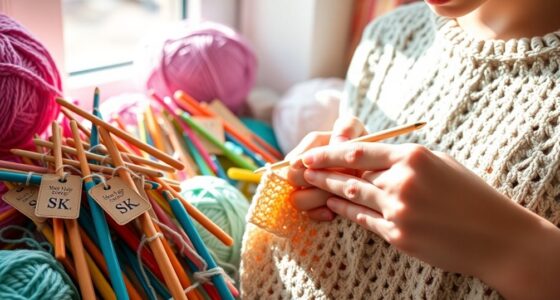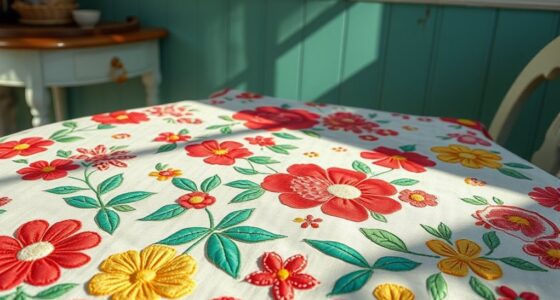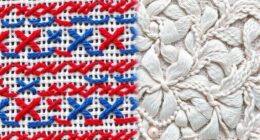When starting your first sock, focus on selecting a comfortable cuff style and easy-to-work yarn like wool blends or acrylics. Solid colors are helpful for practicing techniques, while patterned yarns add flair once you’re comfortable. Pay attention to your tension and choose a yarn weight suited for your project, ensuring a good fit and durability. Experiment with these tips, and you’ll discover more ways to perfect your sock-making skills as you go along.
Key Takeaways
- Choose a comfortable cuff style and yarn to ensure proper fit and elasticity.
- Select beginner-friendly, machine-washable yarns like wool blends or acrylics.
- Use solid colors for practicing techniques and patterned yarns for added visual interest.
- Gather enough yarn plus extra to accommodate mistakes and future adjustments.
- Maintain consistent tension throughout to achieve even stitches and a professional look.

Knitting socks is a rewarding craft that allows you to create cozy, customized footwear for yourself or loved ones. As you start this project, one of the first things you’ll want to consider is the cuff design. The cuff is what sits around the top of the sock and can set the tone for the entire look and fit. You might choose a simple ribbed cuff, which is stretchy and snug, or opt for a decorative pattern like a cable or lace for a more unique appearance. When deciding on a cuff design, think about how tight or loose you want the sock to feel and how much elasticity you need to keep the sock up comfortably. Experimenting with different cuff styles can add personality to your socks and help you develop your knitting skills.
Another vital aspect is yarn selection. The type of yarn you choose influences not just the appearance but also the comfort and durability of your finished socks. For beginners, a smooth, machine-washable yarn like a wool blend or acrylic mix works well because it’s forgiving and easy to work with. Wool provides warmth and elasticity, making it ideal for cozy winter socks, while acrylic blends are more affordable and low-maintenance. When selecting yarn, pay attention to the fiber content and weight. A sport or DK weight yarn is typically best for socks as it strikes a good balance between thickness and flexibility. Avoid thick or overly textured yarns unless you’re aiming for a chunky, statement sock, as these can be more difficult to knit and wear.
As you gather your materials, consider the color and pattern options too. Solid colors are straightforward and great for beginners, allowing you to focus on mastering the knitting techniques. If you want to add some flair, striped or patterned yarns can create interesting effects without much extra effort. Keep in mind that the yarn’s yardage will determine how many pairs you can make, so buy enough to complete your project plus a little extra for mistakes or future projects.
Choosing the right yarn and designing a cuff that fits comfortably can make a big difference in your sock-knitting experience. It helps you build confidence as you learn your way around different stitches and techniques. Once you’ve picked your cuff style and yarn, you’re ready to move on to the main part of the sock, but these initial decisions set the foundation for a successful and enjoyable knitting journey. Additionally, understanding the importance of backing up with proper tension can help you achieve consistent results throughout your project.
Frequently Asked Questions
How Do I Choose the Right Yarn for Sock Knitting?
You should choose a yarn with fiber blends that offer durability, elasticity, and softness for comfortable socks. Look for options like wool blends or superwash wool for easy care and warmth. When it comes to color selection, pick hues that match your style and wardrobe; variegated or solid colors work well. Consider the sock use—more durable yarns for daily wear and softer fibers for cozy, relaxing socks.
What Are the Best Knitting Needles for Socks?
Your socks deserve the best needles, so go for circular needles or double pointed needles—they’re like the superheroes of sock knitting! Circular needles with a flexible cable make seamless knitting effortless and keep your stitches evenly distributed. Double pointed needles are perfect for small circumferences, giving you precise control. Choose high-quality, smooth needles to avoid snags and make your sock knitting journey smooth, swift, and downright enjoyable!
How Can I Fix Mistakes in My Sock Knitting?
To fix mistakes in your sock knitting, start by rewinding mistakes to identify where the error occurred. Carefully unravel the affected stitches, then re-knit them, paying close attention to correcting tension. Use your knitting needle to pick up dropped stitches or fix uneven tension. Don’t rush—taking your time guarantees the correction blends seamlessly. With patience, you’ll improve your technique and enjoy a flawless sock in the end.
What Are Common Sizing Issues When Knitting Socks?
You might face sizing challenges like socks being too tight or loose, often due to inaccurate gauge or pattern issues. To guarantee a better fit, make necessary fit adjustments by measuring your foot and customizing the pattern, especially around the ankle and heel. Keep track of your tension and try on your sock as you go. Proper sizing ensures comfort and prevents frustration during your sock knitting journey.
How Do I Incorporate Patterns or Designs Into Socks?
To incorporate patterns or designs into your socks, start by selecting stitch patterns that complement your color coordination. Use stranded knitting or Fair Isle techniques to add intricate designs, or try textured stitches for visual interest. Plan your pattern placement carefully, and swatch first to make certain your stitch pattern works well with your yarn. This way, your socks will showcase your unique style while maintaining a cohesive look.
Conclusion
Now that you know the basics, your sock knitting journey is just beginning. Think of each stitch as a stepping stone on a path to cozy, handmade comfort. Don’t be afraid to experiment and make mistakes—they’re simply the knots in your tapestry of skill. With patience and practice, your first pair will feel like a warm hug, and soon enough, you’ll be stitching up socks faster than you can say “toe-up.” Happy knitting!









